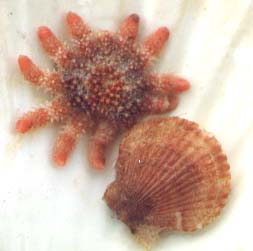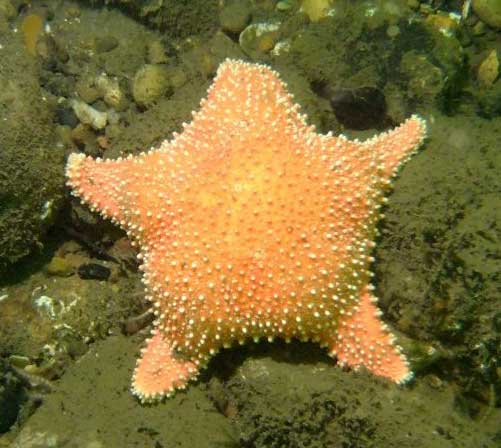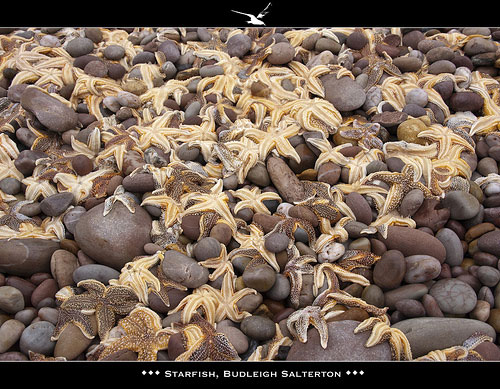
Echinodermata
Starfishes, Sea Urchins, Sea Cucumbers and Related Invertebrates

Cushion Star, Porania pulvillus, and the Sunstar, Crossaster papposus
Echinodermata
Greek echinos = sea urchin, derma = skin.
Marine animals that are
radially symmetrical (most species) and contain a unique water vascular
system, and tube feet that are used for movement, respiration, protection
(spines) and assist in the capture of food.
The Echinodermata are exclusively marine, and most species are intolerant of immersion in low salinity water. One remarkable observation is that they are rarely settled on by barnacles, mussels and other fouling organisms.
Cushion Star, Asterina gibbosa, with the Shore Urchin, Psammechinus miliaris.

Photograph by Robert Jones (Trowbridge)
The Cushion Star is only found on the shore and in the seas to the south and west of the British Isles. The Purple-tipped Shore Urchin has a more widespread distribution but is not particularly common between the tides, although it seem to be known from most rocky coasts where it is usually found attached to the underside of rocks near the low spring tide mark.Brittlestars
MASS MORTALITY OF THE HEART URCHIN, Echinocardium cordatum.
FEATHER STARS
Common Starfish, Asterias rubens
COTTON-SPINNER, Holothuria forskali
More Photographs
Echinoderm
Links
http://www.calacademy.org/research/izg/echinoderm/echilink.htm
The
Echinoderm Newsletter
http://www.nmnh.si.edu/gopher-menus/TheEchinodermNewsletter.html
Echinoderm
Page (External)
http://www.isl.net/~helf/echino/
Photographs
from Loch Fyne
http://www.diworkshop.ndirect.co.uk/Lfyne.htm
Echinoderm
(Aphotomarine)
http://www.aphotomarine.com/starfish_sea_urchin_cucumber_gherkin_echinodermata.html

A small specimen of the Sunstar, Crossaster papposus.
More information links:
Reports of Asterias rubens (Link)
 15
July 2012
15
July 2012
An
Arctic Rigid Cushion Star,Hippasteria
phrygiana,
was spotted on a dive off the Northumberland
coast
in the proposed Marine
Conservation Zone between Coquet
and St Mary’s. This northern species is
one of only two records off an English coast. It usually inhabits the seas
off Greenland
and all over the northern Atlantic although
it it is present in the seas around the Shetland
Isles and it has been trawled
off St. Abbs further north on the same North
Sea coast. This
cushion
star was around 10 cm across and was recorded
at 20 metres depth on a cobble/pebble seabed.
 |
4
June 2012
A rockpooling visit to Worthing Pier on a low (0.4 metres) spring tide produced a surprise Common Brittlestar, Ophiothrix fragilis. |
14
March 2010
 |
 |
|
Photograph by Tony Herbert on flickr |
Photograph by Scott Eley |
Thousands of Common Starfish, Asterias rubens, were washed up on the strandline on the shingle beach at Budleigh Salterton in south Devon (East Devon AONB). The line of washed up starfish stretched for over a mile.
9
December 2009
An
exceptional mass stranding of millions (a galaxy) of Common
Starfish,
Asterias
rubens, stretched in a broad band for over a quarter of a mile
on Holkham Beach on
the north coast of Norfolk.
Their
usual residence would be feeding on the mussel
beds offshore. From a previous occurrence underneath the chalk cliffs east
of Brighton Marina,
Sussex, it is my surmise that the mass migration occurs because the Common
Starfish have exceeded their food supply offshore.
Perhaps, this occurs because of commercial dredging of the mussels.
In this case the stranding could have been exacerbated by north-easterly
gales.
5
December 2009
We
discovered two Sunstars,
Crossaster
papposus, on the beach at Winthorpe, Lincolnshire.
We have never seen these before on this coast although the five legged
Common
Starfish,
Asterias
rubens, are quite common.
26
March 2008
After
a recent bout of northerlies in North Wales I took the dog for a walk down
on Red Wharf Bay
on Anglesey and found
all sorts of things washed up. Much of the material was deposited across
the entire intertidal to the east of the bay, but more concentrated on
the strandline towards the west.
Brittlestars
(various species) were particularly abundant on the upper shore, with patches
a couple of inches (or more) thick. Common
Starfish,
Asterias
rubens, were also very abundant, as a rough guess at 5-10
per square metre with species such as the Sand
Starfish Astropecten
irregularis, and Heart Urchin Echinocardium
cordatum.
23 March 2008
 |
 |
Over Easter, after some heavy storms with snow blowing in off the North Sea, I discovered hundreds of Common Starfish, Asteria rubens, a lot of Sunstars, Crossaster papposus, and Brittlestars washed up on the sands of Holkham Beach, Norfolk.
 |
 |
 |
Hundreds of the sea cucumber Thyone fusus, many exuding their guts and gonads as a response to the stress, were discovered washed dead on up on the shore Newborough in North Wales (only a few nautical miles from Dinas Dinlle).
12
March 2008
This Cotton-Spinner, a sea cucumber properly called Holothuria forskali, was washed up dead on White Strand beach, Cahirciveen, Co. Kerry.
I'd seen live ones in lobster pots but this was the first 'stranded' one I've seen.
December
2006
Two
deep
water sea stars were recorded and collected
by a ROV submersible, the first a beige species with short arms (like a
cushion star) from a depth of around 250 metres off west Norway, and the
second similar one from a depth of 600 metres in a Norwegian fjord at an
earlier date. Neither of these species have been positively identified
at time of writing.
Full
Report with the Links to Images
The
species are suggested as Peltaster placenta
and
Diplopteraster
multipes.
28
January 2006
Thousands
of dead specimens of the Common Starfish,
Asteria
rubens, were washed up on the beach about a mile and a half to
the north of Tywyn
on the Cardigan Bay coast of north-west Wales.
There seem to be various interpretations of these mass strandings, including
winter storms and changes in water temperature.
13
January 2005
Hundreds
of Sea Cucumbers
were amongst the wreck of animal remains discovered on the Dinas
Dinlle beach west of Llanwrog (south-west of Caernarfon), north-west
Wales.
They were scattered all over the strandline and shore with other remains including the common Mermaid's Purses (egg cases of the Dogfish) and the decaying carcass of a dead Seal. Sea Cucumbers are an unusual echinoderm washed up between the tides.
BMLSS Strandline
The sea cucumber looks like Thyone fusus can be found as far north as Norway grows up to 20 cm.
Sea
Cucumbers; General Information - 1
Sea
Cucumbers; General Information - 2
c.
11 June 2003
On
the beach from Sutton-on-Sea up to Mablethorpe, East Lindsey (Easy Yorkshire),
we noticed thousands of dead starfish
ranging from 3-10 cm in size, along with large numbers of dead crabs and
some small shellfish. The starfish were almost certainly the Common
Starfish, Asterias rubens.
Previous Report of a Massive Wreck
27
September 2002
The
pink starfish with 13 legs discovered on Bridlington beach, Yorkshire,
was the Sunstar,
Crossaster
papposus. This is a common
species but it is not often reported washed up on the shore.
A bright orange starfish, Echinaster sepositus, was caught in a bottom gill net near the south-west corner of Guernsey in over 30 metres of water. The fisherman, Ken Robilliard, who caught it and has fished for 25 years says he had never seen this species before. Previous Report
17
March 2002
Thousands
of Common Starfish,
Asteria
rubens, are washed up on the beach at Holkham, Norfolk, on the
east coast of England after sustained north-easterly gales.
c.
14 March 2002
After
a sustained period of north-easterly gales, there was a massive
stranding of marine animals and weed on the Yorkshire shore (north-east
England) between Fraisthorpe and Barmston (East Yorks: Holderness). The
most noticeable of the animals washed up were hundreds of thousands of
starfish mostly of the Common Starfish,
Asteria
rubens, but other species were present.
The list of interesting animals washed up included
decapod
crustaceans
including Lobsters that were still alive,
crabs
etc., a wide variety of fish,
sea
anemones,
polychaete worms, molluscs
including octopuses,
porpoises,
seals
and tonnes of seaweed. This is the largest stranding
recording on these web pages.
Strandline & Beachcombing Page
28
August 1999
A
commercial fishermen found the beautiful orange starfish,
Echinaster
sepositus, north of Herm Island. The
crab potter has fished for 20 years and had never seen one before. The
books say that this starfish reaches the northern part of its range in
the Channel Islands.
Northern Cushion Star
Porania pulvillus
This colourful cushion star is is an exceptional find on the shore and is not often reported by divers, preferring deep cold seas.
Cushion Star
Asterina gibbosa

Cushion
Star on
Constantine Bay beach, north Cornwall
Photograph
by Amanda Bertuchi
This small cushion star inhabits
the shore on south and western rocky coasts of Britain only.
Asterina
spp.
on S W Wales shores (Link)
In late December 20'01, I picked an unusually shaped starfish ( I'd not seen one like this in 22 years of diving ) from a trawlers net on Eyemouth pier (near St Abbs).
I enlisted the help of the National Museum of Scotland and Dr Susan Chambers identified it as a specimen of Hippasteria phrygiana.
More enquiry gleaned the info that the trawler had last fished ' 3 miles off Sunderland' and prior to that 'off Whitby', so the exact location is a bit uncertain.
I got recent records from JNCC - they have 7 from 1974 to 1990 - 3 off Shetland, 3 from NW Scotland and one from Rockall.
Dove Marine Lab have none since 1912.
From internet searches the distribution would seem to be all across the north Atlantic - Stellwagen Bank, Iceland, Faroes.
I also found a good photo by Bernard Picton at - http://www.users.zetnet.co.uk/papa-stour-sac/pics/hippa.jpg
I
found this starfish whilst shore diving at St. Abbs in 1988. It was just
off Maw Carr (Seagull Rock) adjacent to the harbour fairway. As I had never
seen it before in the area, I therefore assumed it was a discard from a
fishing boat entering the harbour. However, boats fishing out of St Abbs
(then as now) do not go further afield than the Firth of Forth (for Nephrops)
so it would appear to have come from a somewhat different area to the one
George found.
I
have a picture but do not know how to attach it.
I can add that this starfish is most plentiful here along the Norwegian coast. Not uncommon to see 10 or more in a dive. Usually most abundant in winter months. Some have commensals.
Glossary of Echinoderm
terms:
Pedicellariae: tiny modified spines topped with 2- or 3-jawed pincers, very mobile and sometimes poisonous, which are used to remove settling larvae and other material from sea urchins (or starfish).
Papulae: little fleshy projections of the body wall in starfish, which give an increased surface area for gas exchange and excretion; large numbers give it a slightly 'furry' look.
Ambulacrum: one of five bands of small plates running from the top to the bottom of a sea urchin, through which the tube feet emerge. The ambulacra are separated by wider inter-ambulacra made up of larger plates. The other echinoderms (starfish; brittlestars; sea cucumbers and feather stars) also have tube feet emerging through ambulacra, but the details are different.
BMLSS Index
BMLSS Invertebrates
BMLSS Species List


